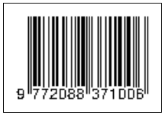Purwarupa Robot Lengan Pemilah Objek Berdasarkan Label Tulisan Secara Realtime
Bryan Novega Whildan Bimantaka(1*), Agus Harjoko(2)
(1)
(2) Jurusan Ilmu Komputer dan Elektronika, FMIPA UGM, Yogyakarta
(*) Corresponding Author
Abstract
Abstrak
Saat ini, perkembangan teknologi robotika tidak hanya pada bidang industri, namun juga mulai merambah dunia pendidikan. Salah satu contohnya adalah kompetisi International Robot Contest (IRC) kategori robot humanoid pada misi pemilahan objek. Bagian tubuh dari robot humanoid yang terpenting dalam pemilahan objek adalah webcam yang digunakan untuk identifikasi objek, dan lengan robot yang digunakan untuk mengambil objek.
Pada penelitian ini, dibuat sebuah robot lengan yang memiliki 4 DOF dan 1 gripper, dengan webcam sebagai sensornya. Robot lengan akan mencari objek bola, kubus, atau kaleng yang tampak dalam jangkauannya, kemudian mengambil objek tersebut dan meletakkannya pada label tulisannya yang telah ditentukan lokasinya. Pengolahan citra digital dilakukan oleh komputer menggunakan pustaka OpenCV. Setelah objek dikenali, robot akan bergerak menggunakan metode inverse kinematics geometri. Proses membaca label tulisan dilakukan dengan menggunakan pustaka Tesseract.
Pengujian pada penelitian ini, pada pengujian pengaruh intensitas cahaya, diperoleh kinerja terbaik untuk identifikasi objek, pada saat intensitas cahaya antara 1,59 cd sampai 15,92 cd untuk objek bola, antara 3,18 cd – 3,98 cd dengan threshold 50 – 200 untuk kaleng, dan antara 2,39 cd – 3,98 cd dengan threshold 50 – 200 untuk kubus. Ketepatan pengambilan objek mencapai 86,67%, dan ketepatan penempatan objek mencapai 100%.
Kata kunci—robot lengan, pemilah objek, pengolahan citra digital, OpenCV, Tesseract.
Abstract
The developments of technology not only in industrialized world, but also the world of education. One example is International Robot Contest (IRC) on humanoid category on object classifying mission.The main part of humanoid robot are both the webcam to identify the objects, and the arm of the robot itself to retrieve the object.
In this study, has been made an arm robot which has 4 DOF, 1 gripper, and a webcam as the sensor. The arm robot will find the object whether ball, can, or cube within reach, take the object and put it on its label which has been located. The digital image processing is done by a computer using OpenCV library. Once the object is identified, then the robot will move by applying geometry inverse kinematics method. While the text label identification is done by using Tesseract.
The tests in this study are done by testing the influence of light intensity during object identification, object retrieval and object placement accuracy testing. The light intensity testing shown the best result at 1,59 cd – 15,92 cd for the ball, 3,18 cd – 3,98 cd with threshold 50 – 200 for the can, and 2,39 cd – 3,98 cd with the threshold 50 - 200 for the cube. The object retrieval accuracy is 86,67%, and the object placement accuracy is 100%.
Keywords—arm robot, object classifier, digital image processing, OpenCV, Tesseract
Keywords
Full Text:
PDFReferences
[1] Farahmand, F., Pourazad, M. T., Moussavi, Z., 2005, An Intelligent Assistive Robotic Manipulator, Engineering in Medicine and Biology 27th Annual Conference, Shanghai, China.
[2] Intel®, Discovery Education, 2011, Calculating Degrees of Freedom of a Robotic Arm, Discovery Education, Discovery Communication, LLC.
[3] Djajadi, A., Laoda, F., Rusyadi, R., Prajogo, T., Sinaga, M., 2010, A Model Vision of Sorting System Application Using Robotic Manipulator.
[4] Poignant, J., Thollard, F., Quenot, G., Besacier, L., 2011, Text Detection and Recognition for Person Identification in Videos.
[5] Gonzales, R. C., Woods, R. E., 2002, Digital Image Processing, Pearsen Education, Inc., Upper Saddle River, New Jersey.
[6] OpenCV, 2013, OpenCV, http://www.opencv.org, diakses pada 18 Juli 2013.
[7] Saha, S. K., 2008, Introduction to Robotics, Tata McGraw-Hill Publishing Company Limited, 7 West Patel Nagar, New Delhi.
[8] Shih, F. Y., 2010, Image Processing and Pattern Recognition: Fundamentals and Techniques, John Wiley & Sons, Inc., Hoboken, New Jersey.
[9] Bradski, G. dan Kaehler, A., 2008, Learning OpenCV: Computer Vision with the OpenCV Library, O'Reilly Media, Inc., California.
[10] Smith, R., 2007, An Overview of The Tesseract OCR Engine, Google, Inc.
[11] Innovative Electronics, 2013, USB2Dynamixel, http://www.innovativeelectronics.com/innovative_electronics/Rbts_usb2dynamixel.htm, diakses pada 20 Juli 2013.
Article Metrics
Refbacks
- There are currently no refbacks.
Copyright (c) 2014 IJEIS - Indonesian Journal of Electronics and Instrumentation Systems

This work is licensed under a Creative Commons Attribution-ShareAlike 4.0 International License.
View My Stats1







